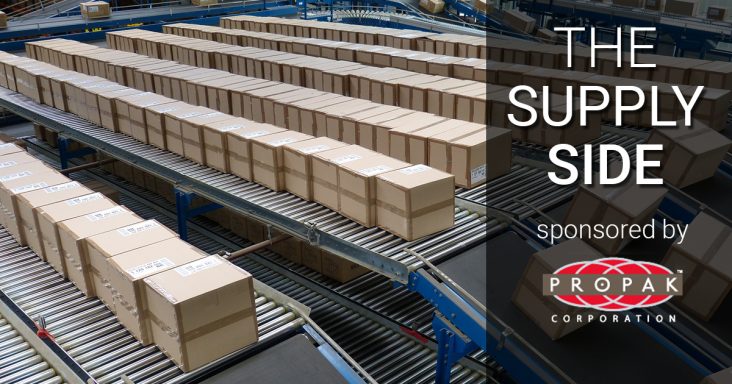The Supply Side: Electronic shelf tags coming to 500 Walmart stores this year
by May 30, 2023 2:46 pm 4,265 views

Walmart Inc. has announced plans to expand electronic shelf pricing technology in the next 18 months to 500 more stores for 60 million shelf labels through a partnership with Vusion. The retail giant began testing the digital technology in some stores about a year ago.
The digital shelf labels are the latest generation of the Vusion platform developed over the past decade by SES-imagotag, a French company considered a global leader in smart and connected digital labels and IoT solutions for physical retail locations. The label technology does not require batteries but is powered by new low-energy Bluetooth technology that works with various compatible devices. The release states that the technology also has a greener footprint compared to the existing electronic shelf labels used in the industry.
“Changing price shelf labels in stores is time intensive for our associates. We’ve been testing digital solutions that will help us manage these price changes electronically, allowing associates more time to do what matters most – helping our customers,” said Bala Prasanna, vice president of store automation and innovation for Walmart U.S. “We’re seeing positive results and are expanding the rollout of these electronic shelf labels.”
At least two Walmart stores in Northwest Arkansas have tested battery-powered electronic shelf labels in the past few years from multiple partnerships. With just one click, a store employee can change the shelf price without physically removing and replacing tags. The Vusion /SES-imagotag labels are getting the green light for further rollout.
According to the release, the enhancement to eliminating batteries and the ability to add sensors to the shelves to monitor aisle traffic are newer developments that made this version more attractive. The added sensors can provide traffic insights to help store management improve store layout, promotion and product displays.
Scott Benedict, director of partnerships at WhyteSpyder, is a former Walmart executive. He said the electronic shelf labels continue to improve and provide a greener solution than the old paper analog systems retailers used for decades. He said the sensor technology that can be added to tag rails could be game changers for store managers to understand the number of shoppers that pass by displays in a given day. That was previously information only known to online customers.
The SES-imagotag labels also allow LED lighting to help improve the efficiency of picking online orders. An employee scans a customer order, and a signal is sent to the electronic shelf label, prompting it to flash. The employee can easily find the correct product to fulfill the order. This method results in faster pick times for store workers.
“Through this roll-out with the undisputed leader of global retail, the new innovative platform will refine the standards and use cases of our industry and open up possibilities for the omnichannel transformation,” said Phillippe Bottine, CEO of SES-imagotag.
Additionally, SES-imagotag employees have already started to work with leading wireless technology partners to integrate this new standard into their communications platforms and provide retailers with an easy and scalable solution for digitizing physical commerce.
A worker at Walmart Store No. 4108 in Springdale told the Northwest Arkansas Business Journal that the new electronic shelf labels would replace paper tags in the store. She said the LED light function would be turned on when the installation and training were completed.
Benedict said price changes have typically been a cumbersome and time-intensive process that includes opportunities for error. He said the one-click price change is easy to set and fix if there is a mistake, unlike reprinting more price tags.
Instacart and midwestern grocery Schnucks have also recently invested in similar electronic shelf labels. Kroger, HyVee and Ahold Delhaize USA also continue to test the technology in select stores.
According to a report from Straits Research, the electronic shelf label market size is projected to reach $3.74 billion by 2030, growing at a compounded annual rate of 16.1%. The report said demand for electronic shelf labels is expanding because of automation in the retail sector and lower prices for digital labels.
The proliferation of the internet of things (IoT) and rising retail sector digitalization continue to impact market expansion. The report states that technology is becoming popular in grocery stores and large mass retailers given the high number of items, workforce challenges and need to automate specific tasks.
“Consumers are growing more price-sensitive and price-aware, increasing the need for smooth price changes and fueling demand for retail automation solutions like electronic shelf labels,” the report noted.
Responding to social media complaints about the new technology, Benedict said it’s unlikely Walmart would raise prices just because it’s easier. He said being a low-cost leader is in the retailer’s DNA. He also noted that Walmart first tests the technology in a few stores to ensure reliability before further investments and rollout.
Walmart has said the company is not surprised the move to digital is liked and disliked by the public, given that has been the reaction to self-checkout and even online grocery shopping.
However, Walmart CEO Doug McMillon’s push toward digitalization continues. He said that by the end of 2026, the plan is for 65% of Walmart stores to be serviced by automation and 55% of fulfillment centers to move through automated facilities. He said the change could result in an average of 20% cost savings.
Editor’s note: The Supply Side section of Talk Business & Politics focuses on the companies, organizations, issues and individuals engaged in providing products and services to retailers. The Supply Side is managed by Talk Business & Politics and sponsored by Propak Logistics.
